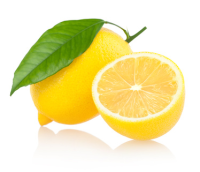Lemon
 Part of the Rutaceae family, the lemon is a small, oval fruit 2 to 3 inches in diameter. The lemon is associated with a sour odor and an acidic or tart taste.
Part of the Rutaceae family, the lemon is a small, oval fruit 2 to 3 inches in diameter. The lemon is associated with a sour odor and an acidic or tart taste.
Overview
The juice of the lemon is mainly made up of sugars and citric "adds." While the outside peel contains several essential oils, the inner flesh is made up of derivatives of coumarin and glycosides. Many people believe all lemons have a sour flavor, but some varieties of the lemon are sweet, such as the Meyer lemon. The two most popular sour lemons are called Eureka and Lisbon.
Because lemon trees are not as hardy in cold climates as orange trees, they can be difficult to cultivate. The lemon tree flowers continuously and bears fruit in all stages of development through most of a year. The typical lemon tree can produce up to 3,000 lemons annually.
History
Citrus fruits have been cultivated for over 4,000 years and are native to Southeast Asia and southern China. Stories about citrus fruits can be found in ancient Asian literature. Lemons were brought to the Middle East between 400 and 600 B.C.E. Arab traders brought lemons, oranges and limes to the Middle East and eastern Africa between C.E. 100 and 700.
When the Arab occupation took place in Spain, citrus fruits arrived as well. Christopher Columbus and explorers from Portugal and Spain brought citrus fruits to the New World. By the 16th Century, lemons were very well known in Brazil and Florida.
Citrus fruits gained immensely in popularity when physicians in the 1890s discovered such fruits could be used to combat scurvy, which is a disease caused by a deficiency of vitamin C. At that time, vendors could ask for as much as $1 per lemon. Scientists later discovered that lemons contain the most concentrated and potent amounts of vitamin C.
Nutritional Information
This fruits is an excellent source of vitamin C. Lemons are also a good source for vitamin B6, folic acid, potassium, flavonoids and limonene. A typical, 100-gram serving of lemon contains 28 calories, 1.1 grams of protein, 9.3 grams of carbohydrates, 2.5 grams of natural sugars, 0.3 grams of fat and 2.8 grams of fiber. Lemons also contain calcium, phosphorous and magnesium.
Health Benefits
Lemons contain the phytochemical limonene. Limonene is showing promise as an anti-cancer agent and is also being studied for its ability to dissolve gallstones. Some health care practitioners consider lemons to be a cleanser and detoxifer for the human body, especially for the liver. Lemons help in fat metabolism. These functions are mostly aided by the astringent qualities of lemons.
The phytonutrients in lemons include coumarins, kaempferol, eriodictyol, limonen and eriocitrin.
Safety
A few people are allergic to the peels of citrus fruits. However, citrus peels should never be eaten.
Lemons contain low levels of oxalates. Those people who have a history of oxalate-containing kidney stones should limit or avoid this particular fruit.
Lemons are also among the foods which frequently have pesticide residues on them. Organically grown lemons may be a better choice.
Selecting and Storing
Lemons should feel heavy. Ripe lemons should be firm with a peel which is fine textured. Acidity can vary with the color of the lemon's skin: deep yellow lemons are less acidic, while greenish-yellow lemons are very acidic.
Lemons should be stored at room temperature but away from sunlight. Without refrigeration, lemons can be stored for about two weeks. If stored in the refrigerator, put the lemons in a plastic bag and keep in the crisper drawer.
For later use, lemons can also be juiced and frozen. Pour the juice from fresh lemons into ice cube trays and freeze. The frozen cubes can also be placed in plastic bags or freezer containers. Frozen lemons will keep for up to three months. The zest of lemons is used as a spice and can be dried and stored in a cool place for about three months.
As with other fruits, the skin should be washed thoroughly before cutting into the lemon to avoid transferring dirt or germs to the surface of the fruit. Also, many harvested fruits have residue of pesticides on the skins which should be washed off.
Serving Ideas for Lemon
Many recipes call for the juice from lemons. To produce more juice, use a room temperature lemon or warm them in a bowl of warm water in a microwave for a few seconds. Roll the lemon with the palm of the hand on a flat surface before cutting.
There are several ways to add lemons to the diet. A few are to:
- Combine lemon juice with flaxseed oil or olive oil, crushed garlic and pepper to make a healthy salad dressing.
- Place thin slices of lemon (including the peels) under and around fish before cooking. The slices can then be eaten along with the fish.
- To cut down on salt intake, use the juice from lemon wedges in place of salt.
References
- Holford, P.(2004). The optimum nutrition bible. London : Piatkus
- Holford, P & Lawson, S. (2008). Optimum Nutrition Made Easy How to achieve optimum health. London : Piatkus
- Murray, M.T. et al.(2005). Encyclopedia of healing foods. London : Piatkus
- Yeager, S. & Prevention Health Books. (1998). The doctors book of food remedies : the newest discoveries in the power of food to cure and prevent health problems from aging and diabetes to ulcers and yeast infections. [Emmaus, Pa.] : Rodale
Posted in Lemon
Ask a Question Or Join a Discussion


